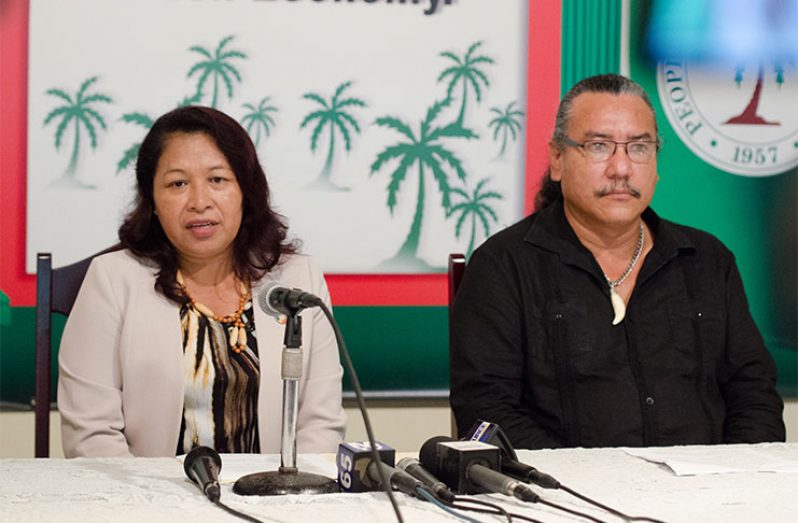THE People’s National Congress Reform (PNCR), the largest partner of the coalition APNU/AFC government, has a longstanding history of service to the Indigenous people of Guyana, and most recently much advocacy has been placed on the preservation, revitalisation and promotion of Indigenous languages in Guyana.
This was emphasised on Friday at the party’s weekly press conference, which was hosted by executive member and Minister of State, Dawn Hastings-Williams, and Adviser to the Minister of Indigenous Peoples’ Affairs, Mervyn Williams – both Indigenous Guyanese.
Minister Hastings-Williams stressed the great emphasis that the APNU/AFC government has placed on preserving the Indigenous languages over the last few years through the incorporation of Indigenous language into the school curriculum, and broadcasts in Indigenous languages across a number of radio stations transmitting in indigenous regions. In Aishalton, Hastings-Williams pointed out, advertisements for contracts are being done in Indigenous languages.
“Indigenous languages across the world are being threatened. When a language is lost, identity is being lost and people remain without an identity,” Hastings-Williams said. She added: “Without information there would be no development. Radio broadcasts in the hinterland provides an opportunity for indigenous peoples to connect and preserve their languages while informing the population. We believe an informed population is an educated population.”
Last year September, the Ministry of Education implemented a programme where Indigenous students are being taught in Indigenous languages at three nursery schools. The ministry introduced the language course at three pilot schools in Region Nine – Maruranau, Sawariwau and Karaudarnau Nursery Schools.
Hastings-Williams said that while the immediate aim is to preserve the Indigenous language by having it more widely used, the possibility of having the languages being used nationally and one day be considered a secondary language of Guyana is also something being hoped for.
She noted that the language barrier created when coast landers go into the hinterland villages could be bridged if Indigenous languages are more widely taught in schools on the coastland as well.
THE United Nations (UN) has designated 2019 as The Year of Indigenous Languages, while the theme of this year’s IDWIP is “Indigenous Languages”.
Hastings-Williams noted that the government’s preservation of the Indigenous languages is just a fraction of the wider developments in the Indigenous communities over the years, particularly in the area of education.
“The PNCR has a proud history in and out of government of service to our Indigenous communities. It was the PNC in government that initiated a progressive education policy for the Indigenous People of Guyana. It was the PNC government that established the policy of taking secondary education to the hinterland and the Indigenous People, rather than forcing them to study on the coastland. The administration expanded primary education by building schools,” Hastings-Williams noted.
In terms of infrastructural developments, Hastings-Williams pointed out that primary education was expanded by the building of schools in the Aranaputa Valley and Monkey Mountain, partly through self-help. Eleven government-aided, all-age schools were built in Konashen, Maruranau, St Ignatius, Sand Creek, Toka and Yakarinta in the Rupununi, and Kamarang in the Cuyuni Mazaruni Region, as well as Matthew’s Ridge, Port Kaituma, Kwebanna and Waramuri in the Barima Waini Region and Orealla in the East-Berbice-Corentyne Region.
“It was the PNC in government that established the five-year Hinterland Scholarship programme, which funded tuition, allowances to buy books and clothing and return passages to their homes. The PNCR is proud of the progress and development that is taking place in our Indigenous communities, especially in the area of education and public health,” she said.
Adding to her remarks, Mervyn Williams noted that much money has also been invested into the communities over the past few years. “The coalition government continues to fulfil its mandate for the development of Indigenous communities,” Williams said.
“The presidential grant, which this government has more than doubled, is one of the major interventions being undertaken and managed for better outcomes throughout Indigenous communities by the government. In 2016 the Jubilee Grant saw $280.5M disbursed to 212 villages, satellites and communities. In 2017 another $215M was approved for 215 Indigenous people’s villages, satellites and communities.”
Also towards hinterland development, the government has paved some 80 per cent of Madhia’s roads with reinforced concrete, which is expected to last some 30 years. Also in Madhia, some $27M went to the extension of the Madhia Primary School. A $33M expansion is scheduled for Chinapow Primary School.



.jpg)









